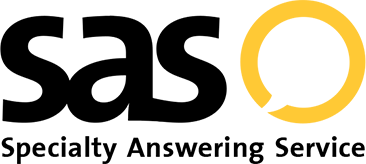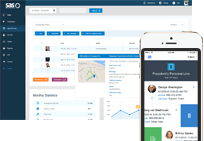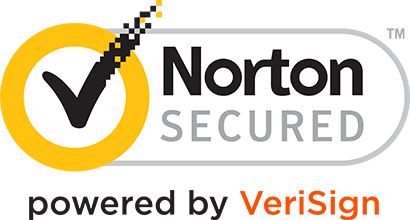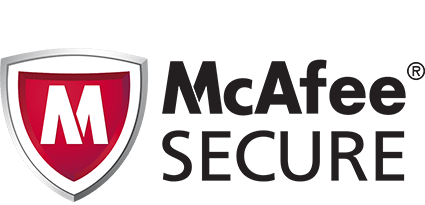- Log In
- Support
- Company
- Contact Us
- Live answers @ 1-888-532-4794
What is Saas infographic.
Software as a Service (SaaS) is a product that enables businesses to use software applications on a subscription basis without needing to keep up with maintenance, including systems like Salesforce, Zendesk, Office 365 and Google Apps. Using SaaS can be a cost effective and time efficient alternative than using a traditional software model, as support, training, infrastructure and software security are all handled by the vendor.
If you’re a company looking to utilize a SaaS product but not sure how to choose one, you will want to consider factors such as the nature and size of your business, evaluating qualitative and technical risks, and evalutating strategic benefits. Keep reading to learn more about Software as a Service and how it could benefit your business.
[html]
<img title=”What is SaaS Infographic” alt=”What is SaaS Infographic” src=”https://www.specialtyansweringservice.net/wp-content/uploads/SaaS-Infographic.jpg” width=”710″ height=”5461″ />
<pre><em>Image originally posted on <a href=”https://www.specialtyansweringservice.net/what-is-saas-infographic/”>The SAS Blog</a></em>
[/html]
What is SaaS?
Software as a Service (SaaS) enables companies to use software applications on a subscription basis without the hassles of maintenance and upgrades.
- The annual ownership cost of software applications can be up to four times the initial purchase cost.
- Most companies spend 75% of their IT budget on maintaining and running existing systems and software.
- The purchase price of a software license accounts for only 5% of the total cost of ownership (TCO).
Traditional Software vs. SaaS
Traditional Software Model
- A traditional software model is one where there is a large upfront license cost followed by annual support costs.
- Key features are provided up front, with periodic upgrades charged separately.
- License costs depend on parameters not directly linked to the software usage such as server type, number of CPUs, etc.
- As the number of users increases, other costs such as hardware and IT support also increase.
- Extra costs include hardware, server, backup, networking, and security costs to protect the software from unauthorized access and malware attacks.
- Most traditional software packages are highly customizable.
- End-user training is another cost element in the traditional software model.
Software as a Service (SaaS) Model
- Software as a Service (SaaS) is an on-demand, pay-as-you-go model.
- There is usually a recurring subscription fee that increases with usage.
- The pricing model is typically linked to either the number of users or the number of transactions.
- Changes in network security settings may be required to allow access to the SaaS application.
- Support, training, infrastructure and software security are all handled by the SaaS vendor.
- The SaaS model is designed to work anywhere, anytime.
- A good vendor ensures easy software scalability to handle usage spikes, network outages, etc.
Single-Tenant vs. Multi-Tenant Architecture
The key difference between traditional software and SaaS models in in their architecture. While traditional software models are typically single-tenant models, SaaS is usually multi-tenant.
- Single-tenant architecture: The enterprise buys the software and installs it on a server that runs only that application and serves only the end-user group of that enterprise.
- Multi-tenant architecture: The hardware infrastructure is shared among several customers although each instance will be secured and segregated from the other.
Advantages of SaaS Application in Contact Centers
- With SaaS, the IT budget will go towards software subscription fees.
- The cost for each customer continues to drop as the vendor acquires new customers.
- The SaaS vendor will host the applications and provide dedicated support staff.
- SaaS makes it easy to accommodate variations in transaction volume.
- The contact center does not have to invest in hardware infrastructure or IT staff training.
- SaaS is delivered through the web or thin clients, reducing configuration requirements.
- The enterprise can choose to buy only the number of subscriptions that it needs.
Costs to Consider for SaaS vs. Traditional Software
Traditional Software:
- Software licenses
- Hardware and network infrastructure costs
- Testing tools
- Security architecture
- Physical facilities to house the servers
- With software upgrades, further capital expenses may be necessary
Software-as-a-Service:
- Service fee for using the software
- Maintenance
- Support
- Upgrades
- Training
Design & Deployment
Traditional Software
- High cost to design, configure, test, integrate and launch traditional software.
- Staff training and change management are other major expenses.
Software-as-a-Service
- SaaS is easier to deploy than traditional software, and more cost-effective
Recurring Infrastructure Costs
Traditional Software
- Must rely on network monitoring and management tools for real-time problem correction.
- Maintenance and support contracts, hardware and network upgrades contribute to TCO.
- Other costs include:
- Capacity increases
- Multiple redundant systems
- Add-on features
- Repair costs
- Power consumption
Software-as-a-Service
- The only recurring infrastructure cost is additional bandwidth to access the application.
- Additional costs for hardware and network infrastructure are the vendor’s responsibility.
How to Choose the Right SaaS Platform
- Evaluate strategic benefits: Due to the fact that the software, data storage and computing process are all done remotely, the SaaS model is easily scalable both upwards and downwards.
- People retention: It is difficult to attract and retain IT talent. SaaS helps to avoid difficulty in talent procurement for database and server management.
- The nature and size of the business: Have a customized checklist to evaluate suitability of SaaS vs. premise software for your specific needs.
- Qualitative and technical risk evaluation: Success depends on how well the vendor addresses qualitative risks perceived by end-users, such as training support and change management.
- Peer group evaluation: Before deciding on a vendor, it is necessary to ask for references from a similar industry in terms of business volume and sectors handled.
Categories
- Advice (32)
- Answering Service 101 (18)
- Best Practices (10)
- Call Center Jobs (6)
- Call Center Software (20)
- Comparison (2)
- Customer Service (30)
- Funny (31)
- Holidays (19)
- Industry Hacks (19)
- Infographics (53)
- International (1)
- Medical (8)
- News (12)
- Phone Etiquette (2)
- Phones (14)
- Pricing (8)
- Quizzes (3)
- Receptionist (11)
- SAS Products (29)
- Scripting (4)
- Services (5)
- Small Business (25)
- Starting Up (7)
- Tips and Tricks (19)
- Uncategorized (1)
- Videos (19)
- Workplace (6)
Recently writen
- Call Center Script Best Practices: Advanced Script Block Tips to Optimize Your Answering Service
- January 2025 Release Notes – Adjustments to Call Details Timeline, New Scripting Updates, Live Transcription, and more!
- April 2024 Release Notes – Voicemail Greetings, Ability to Access Websites With a Username and Password, and more!
- March 2024 Release Notes – New Add-On, Settings Revamp, and more!
Follow Us
How about a demo?
We'll show you how our web portal works and answer any questions you have about SAS.
Schedule a demo








